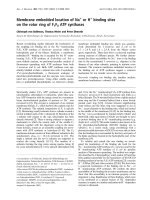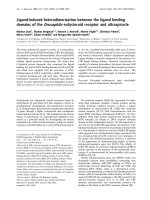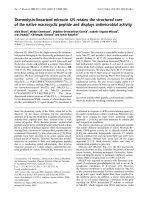Báo cáo y học: " VACTERL (vertebral anomalies, anal atresia or imperforate anus, cardiac anomalies, tracheoesophageal fistula, renal and limb defect) spectrum presenting with portal hypertension: a case report" pdf
Bạn đang xem bản rút gọn của tài liệu. Xem và tải ngay bản đầy đủ của tài liệu tại đây (301.05 KB, 3 trang )
JOURNAL OF MEDICAL
CASE REPORTS
Bhurtel and Losa Journal of Medical Case Reports 2010, 4:128
/>Open Access
CASE REPORT
BioMed Central
© 2010 Bhurtel and Losa; licensee BioMed Central Ltd. This is an Open Access article distributed under the terms of the Creative Com-
mons Attribution License ( which permits unrestricted use, distribution, and reproduc-
tion in any medium, provided the original work is properly cited.
Case report
VACTERL (vertebral anomalies, anal atresia or
imperforate anus, cardiac anomalies,
tracheoesophageal fistula, renal and limb defect)
spectrum presenting with portal hypertension: a
case report
Dilli Raj Bhurtel*
1
and Ignatius Losa
2
Abstract
Introduction: We report for the first time a unique case of VACTERL (vertebral anomalies, anal atresia or imperforate
anus, cardiac anomalies, tracheoesophageal fistula, renal and limb defect) spectrum associated with portal
hypertension. The occurrence of both VACTERL spectrum and extrahepatic portal hypertension in a patient has not
been reported in the literature. We examined whether or not there was any association between extrahepatic portal
hypertension and VACTERL spectrum.
Case Presentation: A two-and-half-year-old Caucasian girl with VACTERL spectrum presented with hematemesis and
abdominal distension. She had caput medusae, ascites, splenomegaly, gastric and esophageal varices. Her liver function
tests were within normal limits. Magnetic resonance imaging of the liver with contrast showed a thready portal vein
with collateral vessels involving both right and left portal veins without intrahepatic duct dilation.
Conclusion: A thready portal vein, with features of extrahepatic portal hypertension, is a rare non- VACTERL-type
defect in patients with VACTERL spectrum. Understandably, clinicians should give low priority to looking for portal
hypertension in VACTERL spectrum patients presenting with gastrointestinal bleeding. However before routinely
looking for a thready portal vein and/or extrahepatic portal hypertension in asymptomatic VACTERL spectrum patients,
we need further evidence to support this rare association.
Introduction
The clinical manifestation of VACTERL association
includes vertebral anomalies, anal atresia, congenital
heart disease, tracheoesophageal fistula, renal dysplasia
and limb abnormalities [1]. Portal hypertension results
from the elevation of portal venous pressure. The late
consequences of portal hypertension may be esophageal
varices, gastric varices, splenomegaly, ascites, and caput
medusae [2]. The association of VACTERL spectrum and
portal hypertension in a child has not been reported so
far. We report a case of VACTERL association with portal
hypertension and discuss the possibility of a common eti-
ology.
Case presentation
A two-and-half-year-old Caucasian girl presented with
hematemesis. A systemic inquiry revealed no other
symptoms. She was noted to be very small, with growth
below the 3rd centile. She was pale, very alert, active and
playful. Her abdominal examination revealed prominent
superficial veins with splenomegaly measuring 6 cm from
the costal margin. The rest of her systemic examination
was normal.
Her stool was positive for occult blood; however her
complete blood count, coagulation profile, extended clot-
ting study, and thrombophilia screen were all within nor-
* Correspondence:
1
Addenbrooke's Hospital, Cambridge University NHS Trust, Hills Road,
Cambridge CB2 0QQ, UK
Full list of author information is available at the end of the article
Bhurtel and Losa Journal of Medical Case Reports 2010, 4:128
/>Page 2 of 3
mal limits. She had had a Meckel's abdominal scan which
came back normal. Her liver function which was repeat-
edly checked remained within normal limits.
Our patient was born by emergency lower segment
Cesarean section (EmLSCS) due to fetal distress at 33
weeks' gestation. Her parents were non-consanguineous
Caucasians. At birth her mother was 34 years of age, a
non-smoker and a non-alcoholic; and she was on pro-
phylthyouracil for a hyperactive thyroid. Antenatal his-
tory revealed that her pregnancy had been complicated
by pregnancy-induced hypertension. Fetal growth had
been monitored regularly for suspected growth restric-
tion. Ultrasound scan had confirmed the restricted
growth and a Doppler ultrasound scan had been abnor-
mal with absent end diastolic flow. There had been no
oligo- or polyhydramnios. Antenatal TORCH (toxo-
plasma, rubella, cytomegalovirus, Herpes Simplex), HIV,
Treponemma and Hepatitis screening were all normal.
Our patient was born in a good condition with Apgars
of 9 at one minute and 10 at five minutes. Her weight was
1250 g at birth, which was below the 3rd centile for her
age and sex. She was noted to have an imperforate anus,
with a rectovaginal fistula. She had heart murmur, and a
subsequent echocardiography confirmed perimembra-
nous ventricular septal defect (VSD) and persistent fora-
men ovale. An X-ray of her spine confirmed the
hemivertebrae on her sacrococcygeal spine. She had had
surgical correction of her imperforate anus and rectovag-
inal fistula within the first few days of life.
She had spent four weeks in the neonatal unit before
being discharged home. She was doing well at home until
she presented to us at two and half years of age with
effortless vomiting of blood. Her growth trajectory had
always remained below the 3rd centile.
She had had different tests following her admission
with hematemesis. An ultrasound of her abdomen con-
firmed splenomegaly, and a Doppler sonography showed
a thready portal vein with correct directional low velocity
flow towards the liver.
Magnetic resonance imaging (MRI) of her liver, using a
gadolinium contrast agent, confirmed splenomegaly with
gastric, retroperitoneal and splenic varices. The portal
vein was thready (Figures 1 and 2) with collateral vessels
involving both left and right portal veins. There was no
evidence of intrahepatic duct dilation in the gadolinium-
enhanced MRI scan of the liver.
Discussion
Our patient had an imperforate anus with a rectovaginal
fistula, perimemebranous VSD, persistent foramen ovale
and vertebral anomalies; features associated with a
VACTERL spectrum. She also had splenomegaly, gastric,
retroperitoneal and splenic varices, along with dilated
superficial abdominal veins which were the late seqelae of
portal hypertension. MRI of the liver with contrast
showed a thready portal vein with collateral vessels
involving both right and left portal veins without intrahe-
patic duct dilation.
Figure 1 Coronal section of the gadolinium-enhanced MRI scan
of the liver and portal system. The image shows a thready portal vein
(arrow) with collateral vessels involving both left and right portal veins.
Figure 2 Thready portal vein with prominent collaterals seen in
the coronal section of the gadolinium-enhanced MRI scan.
Bhurtel and Losa Journal of Medical Case Reports 2010, 4:128
/>Page 3 of 3
Non-VACTERL-type defects like single umbilical
artery, genital defects and respiratory tract anomalies
have been frequently described in patients with
VACTERL association [3]. De Jong EM et al. stated that
70% of cases with VACTERL spectrum had additional
non-VACTERL-type defects, with high occurrences of
single umbilical artery (20%), genital defects (23.3%) and
respiratory tract anomalies (13.3%).
Extrahepatic portal hypertension in children with nor-
mal liver function is not especially uncommon. The most
common cause is portal vein thrombosis (PVT). Portal
hypertension in our patient was noticed at two and half
years of age when she presented to us with hematemesis.
She was investigated for a possible etiology. Her throm-
bophilia screen and liver function tests were normal. Her
imaging of the liver and portal system showed a thready
portal vein with collaterals arising from the right and left
portal veins.
Ando et al. studied portal venous anatomy in 10
patients with extrahepatic portal vein obstruction with-
out hepatic disturbances ranging in age from one to seven
years (mean age, 4.2 years) using ultrasonography, portal
venography, computed tomography cholangiography and
MRI [4]. The extrahepatic portal vein was not obliterated,
but it crossed over the common bile duct from the left to
the right side at the cranial level of the pancreas and ran
in a cranial direction along the right side of the common
bile duct or coiled itself around the bile duct. Thus, the
extrahepatic portal vein formed a tortuous eta-shape.
The portal vein was not obstructed in patients with extra-
hepatic portal vein obstruction but formed a characteris-
tic eta-shape by coiling itself around the common bile
duct, suggesting that extrahepatic portal vein obstruction
has an embryological cause. We postulate that the
thready portal vein seen in our patient could be another
structural defect which had led to portal hypertension.
No definite gene has been identified to explain the
VACTERL association and the etiology is not yet con-
firmed [5]. However during early embryonic develop-
ment, disruption occurs, leading to different
malformations of the heart, skeleton, muscle and blood
vessels of the VACTERL spectrum. The disruption
occurs in the differentiation of the mesoderm leading to
the different malformations of the VACTERL spectrum.
It will be very difficult to derive any conclusion from a
single case however it is worth looking at the possibility
of future studies of VACTERL spectrum patients.
Conclusion
Our case is the first of case of its type with VACTERL
spectrum and extrahepatic portal hypertension. A
thready portal vein, with features of extrahepatic portal
hypertension, may be one of the non-VACTERL-type
defects in patients with VACTERL association. But
before actively looking for a thready portal vein and or
extrahepatic portal hypertension in VACTERL spectrum
patients, we need more evidence to support this hypothe-
sis.
Consent
Written informed consent was obtained from the
patient's next-of-kin for publication of this case report
and any accompanying images. A copy of the written con-
sent is available for review by the Editor-in-Chief of this
journal.
Competing interests
The authors declare that they have no competing interests.
Authors' contributions
DRB and IL both identified the case and prepared it. DRB collected the detailed
information about the presentation of the case. All the investigations were col-
lected and individually reviewed by DRB. MRIs were collected from St James
Hospital. IL provided the detail information of the antenatal and significant
past medical history. Both authors read and approved the final manuscript.
Acknowledgements
We would like to thank the Radiology Department, St James' Hospital, Leeds,
UK for providing the images of the scans. We would also like to thank the Clini-
cal Science Library, Macclesfield District Hospital for providing the journals.
Author Details
1
Addenbrooke's Hospital, Cambridge University NHS Trust, Hills Road,
Cambridge CB2 0QQ, UK and
2
Macclesfield District General Hospital,
Macclesfield, UK
References
1. Czeizel A, Lundanyl I: VACTERL-association. Acta Morphol Hung 1984,
32(2):75-96.
2. Sanyal AJ, Shah VH: Portal Hypertension: Pathobiology, Evaluation, and
Treatment. In (Book review: N Engl J Med) Volume 353. Issue 24 Totowa, NJ:
Humana Press; 2005.
3. De Jong EM, Felix JF, Deurloo JA, van Dooren MF, Aronson DC, Torfs CP,
Heij HA, Tibboel D: Non-VACTERL-type anomalies are frequent in
patients with esophageal atresia/tracheo-esophageal fistula and full or
partial VACTERL association. Birth Defects Res Part A Clin Mol Teratol 2008,
82(2):92-97.
4. Ando H, Kaneko K, Ito F, Seo T, Watanabe Y, Ito T: Anatomy and etiology
of extrahepatic portal vein obstruction in children leading to
oesophageal varices. J Am Coll Surg 1996, 183(6):543-547.
5. Shaw-Smith C: Oesophageal atresia, tracheo-oesophageal fistula, and
the VACTERL association: review of genetics and epidemiology. J Med
Genet 2006, 43(7):545-554.
doi: 10.1186/1752-1947-4-128
Cite this article as: Bhurtel and Losa, VACTERL (vertebral anomalies, anal
atresia or imperforate anus, cardiac anomalies, tracheoesophageal fistula,
renal and limb defect) spectrum presenting with portal hypertension: a case
report Journal of Medical Case Reports 2010, 4:128
Received: 25 April 2008 Accepted: 5 May 2010
Published: 5 May 2010
This article is available from: 2010 Bhurtel and Losa; licensee BioMed Central Ltd. This is an Open Access article distributed under the terms of the Creative Commons Attribution License ( which permits unrestricted use, distribution, and reproduction in any medium, provided the original work is properly cited.Journal of Medical Case Repo rts 2010, 4:128









